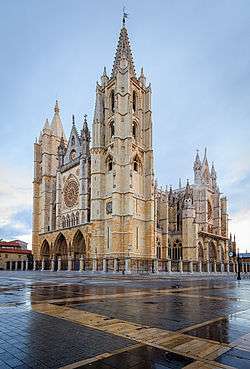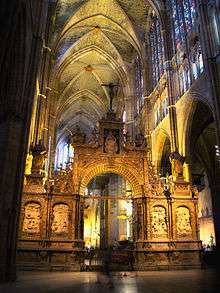León Cathedral
| León Cathedral | |
|---|---|
 | |
| 42°35′58″N 5°34′0″W / 42.59944°N 5.56667°WCoordinates: 42°35′58″N 5°34′0″W / 42.59944°N 5.56667°W | |
| Country | Spain |
| Denomination | Roman Catholic |
| Website | www.catedraldeleon.org/ |
Santa María de León Cathedral, also called The House of Light or the Pulchra Leonina is situated in the city of León in north-western Spain. It was built on the site of previous Roman baths of the 2nd century which, 800 years later, king Ordoño II converted into a palace.
Current structure

The León Cathedral, dedicated to Santa María de la Regla, was declared of Cultural Interest in 1844. It is known as the Pulchra Leonina and is a masterpiece of the Gothic style of the mid-13th century. The design is attributed to the architect Enrique. By the late 16th century it was virtually completed.
The main façade has two towers. The southern tower is known as the 'clock tower'. The Renaissance retrochoir contains alabaster sculptures by Jusquin, Copin of Holland and Juan de Malinas. Particularly noteworthy is the Plateresque iron grillwork screen or reja in the wall behind the sepulchre of King Ordoño.
It has three portals decorated with sculptures situated in the pointed arches between the two towers. The central section has a large rose window. Particularly outstanding is the image of the Virgen Blanca and the Locus Appellatione, where justice was imparted.
The church has nearly 1,800 square meters of stained glass windows. The great majority of them date from the thirteenth to the fifteenth century: a rarity among medieval gothic churches.
In the Main Chapel, there is an altarpiece by Nicolás Francés (15th century) and a silver urn containing the relics of San Froilán, the town's patron saint, made by Enrique de Arfe. The 13th- to 15th-century cloister contains sculpted details in the capitals, friezes and ledges.
The Cathedral Museum houses a large collection of sacred art. There are almost 1,500 pieces, including 50 Romanesque sculptures of the Virgin, dating from pre-historic times to the 18th century (Neoclassicism) with works by Juan de Juni, Gregorio Fernández, Mateo Cerezo, a triptych of the School of Antwerp, a Mozarabic bible and numerous codices. The first manuscript in Leonese language, the Nodicia de Kesos, can be found in its archives.
The Leon cathedral is also one of the three most important cathedrals, along with that of Burgos and Santiago de Compostela, on The Way of Saint James (or in Spanish, El Camino de Santiago).
History
Previous constructions
- The Roman baths and the first cathedral
Originally, under the current location of the cathedral, the Legio VII Gemina had built the baths, with a size larger than the current building. During the great restorations of the nineteenth century its remains were discovered, and in 1997 others were explored near the south façade.
During the Christian reconquest the ancient Roman baths were converted into a royal palace. King Ordoño II, who had occupied the throne of Leon in 916, defeated the Arabs in the Battle of San Esteban de Gormaz in 917.[1] As a sign of gratitude to God for victory, he gave up his palace to build the first cathedral. Under the episcopate of Fruminio II, the building was transformed into a sacred place. The tomb of Ordoño II of Leon, who died in 924, is found in the cathedral.
The temple was guarded and governed by monks of the Order of St. Benedict, and it is likely that its structure was very similar to many others existing during the Leonese Mozarabic period. Almanzor campaigned through these lands in the late 10th century, devastating the city and destroying the temples. However, damage to the building of the cathedral appears to have been rapidly addressed, since in the year 999 King Alfonso V was crowned in the church.
After the political turmoil and Moorish raids that lasted till 1067 the state of the cathedral was in extreme poverty. This would move to King Ferdinand I of León, who, after transferring the remains of San Isidoro to León, sought to restore the temple. This king achieved success in the expansion of the kingdom.
- The Roman cathedral
With the help of Princess Teresa Urraca of Navarre, sister of the king, the construction of a second cathedral, was started, and within its architecture. It fell within the Pelayo II episcopal see. Its style was essentially Romanesque, built in brick and masonry, with three naves finished in semicircular apses, the central one dedicated to Saint Mary, as in the previous church. While the cathedral was built according to the international style, examination of what has survived of its original facade, its originally indigenous nature can be noted. There is still the use of the horseshoe arch, at least decoratively. The cathedral was consecrated on November 10, 1073 during the reign of Alfonso VI. Presumably the same masons who were building the Basilica of San Isidoro of Leon worked on it.
This cathedral remained standing until the end of the next century. When the last proprietary king of Leon, Alfonso IX, rose to the throne, the city and the kingdom witnessed major social, artistic, and cultural changes.
The Third Cathedral
Construction of the third cathedral, now Gothic in style, began circa 1205, but problems with the foundation delayed continued work until 1255 under Bishop Martín Fernández with the support of King Alfonso X of Castile and León. The design is attributed to the master Enrique, perhaps a native of France, who had previously worked on the Cathedral of Burgos. Clearly, he knew the Gothic architectural form of the Isle of France. He died in 1277 and was replaced by the Spaniard Juan Perez. In 1289, Bishop Martín Fernández was also dying when the front of the temple was already open for worship. The basic structure of the cathedral was finished soon, and in 1302 Bishop Gonzalo Osorio opened the whole church to the faithful. However, during the fourteenth century the cloister, the north end tower were at last to be finished, and the south tower was not completed until the second half of the fifteenth century.
The Cathedral of Leon, like its sister predecessor, Burgos Cathedral, follows the layout of the Rheims Cathedral (although at a reduced scale). Like most French cathedrals, the one of Leon is built with a geometric module based on the triangle (ad triangulum), the primary lines of which relate to the square root of 3, and to which respond all of the parts and the whole. This aspect, as with the layout, the elevations, and the decorative and symbolic repertoires, makes this cathedral an authentic trans-Pyrenee building, removed from Hispanic fashion and belonging to the purest school of French Champagne. This has earned it the epithets of being "the most French of Spanish cathedrals" or the Pulchra Leonina (the Beauty of Leon), since its formal features are related to the Gothic style of Champagne.
In addition to its layout, the Cathedral of Leon is also inspired by that of Rheims in its structure, the form of the chapels of its ambulatory (in this case polygonal), and the development of its transept. The influence of Chartres Cathedral can be seen in the western porch. The one in Leon abandons the model of Rheims Cathedral in the elevations beyond the body of the clerestory, as it is transparent there and it accommodates the technical progress achieved in the Sainte Chapelle and Amiens Cathedral.
French influence is also found in developing the chancel, where initially the choir was to be put according to their custom. Specifically Leonese is the location of the cloister, with no organic tie to the temple, the exit in the floor plan of the towers of the main facade, displaying the elevation of the buttresses of the nave, and the discontinuity of the five naves at the front end of the main area of the temple, which were reduced to three.
The problem was that much of the foundation site sits upon Roman ruins, hypocausts of the second century, hampering a good foundation for the pillars. The accumulation of moisture and water seepage caused serious inconveniences to the master builders. Besides that, most of the stones of the cathedral are of poor quality rock, a limestone, with little resistance to atmospheric agents. In addition, the subtlety of its style is a challenge to its construction materials; the numerous supports are extremely fragile, the lines are reduced to a total optimization, to such a degree that several architects of the time questioned whether such a project could remain standing. This almost unreal structure, together with the poor quality of the stone and its poor foundation, forced it to suffer constant interventions and restorations from the fifteenth century on, changing the temple into a European model for transformative intervention, restoration and conservation.
Bibliography
In Spanish
- Ricardo Puente, La Catedral de Santa María de León. León, Imprenta Moderna. Editor Ricardo Puente.
- Luis A. Grau Lobo, La Catedral de León. León, Editorial Everest.
- José Javier Rivera Blanco, Las Catedrales de Castilla y León (parte correspondiente a la catedral de León). León, Editorial Edilesa.
- Juan Eloy Díaz-Jiménez, Catedral de León. El retablo. Madrid, Tipografía de la Revista de Archivos, Bibliotecas y Museos, 1907.
- Inventa Multimedia, La Catedral de León. Exposición: El sueño de la razón.. Avilés, Inventa multimedia, S.L., 2001. web del proyecto
- Laviña, Matías (1876). La Catedral de León. Memoria (Facsímile). España: Editorial Maxtor. ISBN 84-95636-48-4.
External links
| Wikimedia Commons has media related to Catedral de Leon. |
- InFocus: León Cathedral (León, Spain) at HitchHikers Handbook
- Official Site of León Cathedral
- Webcam of León Cathedral
References
- ↑ "Historia de San Esteban de Gormaz". Retrieved 5 June 2012.

